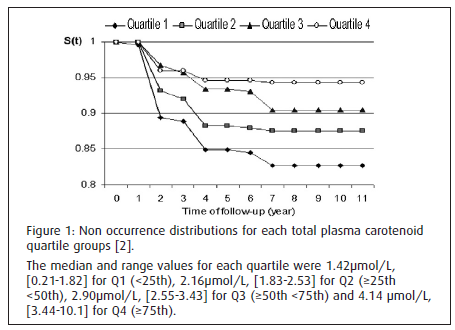Plasma Carotenoids and Onset of Dysglycemia: Results from the EVA study
Carotenoids are natural pigment found in food, especially in fruits and vegetables. Background has led to the hypothesis that carotenoids play a protective role in chronic diseases1 and cancers. In this report2, we investigated if carotenoids could have a role in diabetes incidence in the elderly, possibly through their antioxidant capacity. We explored the relationships between total plasma carotenoid at baseline and 9-year occurrence of type 2 diabetes or impaired fasting glucose (IFG) in a healthy elderly population: The EVA Study (“Epidemiology of Vascular Ageing”).
The EVA Study is a nine-year longitudinal study3 that, at baseline (EVA0, 1991-1993), included 1389 volunteers (574 men and 815 women) born between 1922 and 1932 (mean age = 65) who resided in the town of Nantes (Western France). The subsequent follow-up waves with biological measurements were EVA2 (2-year follow-up, n=1272), EVA3 (4-year follow-up, n=1188) and EVA6 (9-year follow-up, n=781). The present analyses carried on the 1165 participants who were normoglycemic at inclusion. Total plasma carotenoid was measured at baseline using a spectrophotometric assay and analysed by quartile. During the 9-year follow-up, cumulative incidence of dysglycemia (presence of IFG or diabetes status identified according to the WHO definition4) was considered.
Main finding
During the 9-year follow-up, 127 new cases of dysglycemia (including 27 cases of type 2 diabetes) occurred. Comparisons of survival distributions between quartiles of plasma carotenoids showed that the lower the quartile, the greater the occurrence of dysglycemia (Figure 1). After controlling for socio-demographic factors, smoking habits, alcohol intake, cardio-vascular disease history, blood pressure, BMI and lipid profile, Cox proportional hazards regression models showed that participants in the highest quartile of total plasma carotenoids had a reduced 9-year risk of dysglycemia compared to participants in the lowest quartile (Higher quartile vs. lower quartile : 0.42 [0.22;0.82], P=0.01). To take into account reversibility of IFG, sensitivity analyses with persistent IFG as an end point were performed and showed a similar graded association between quartiles of carotenoids and dysglycemia.
Discussion
To our knowledge, our study2 is one of the few to explore longitudinally the relationship between carotenoid and dysglycemia.

Currently, the mechanism of this potential relationship is still under debate and as described by Paiva et al., several hypothèses may explain this observation5. One of them involves the antioxidant properties of carotenoids. In our study, analyses were repeated after controlling on various antioxidative markers (TBARS, vitamin E, activity of glutathione peroxidases and superoxide dismutase), and our results remained unchanged suggesting that the association between total plasma carotenoids and diabetes observed in our cohort is independent of the oxidative stress status of subjects.
High plasma carotenoid is also a marker of fruits and vegetable consumption7. A reduced risk of type 2 diabetes with vegetables consumption was suggested in several studies7, 8 but not all9. This possible protective effect of vegetables and fruits consumption in diabetes could result from the combined action of many protective compounds including antioxidants and could explain the controversial results in the literature between studies which were interested in blood measurement levels of carotenoids and those which were interested in consumption of carotenoid-rich vegetables and fruits.
Finally we cannot exclude that carotenoids might have been serving as markers for other protective lifestyle habits and health behaviours but are not acting as effective agents themselves. In conclusion, our results bring support to a possible role of carotenoids in onset of IFG and type 2 diabetes in elderly people. Further studies are necessary to confirm this observation and to explore the mechanism which could explain the relationship, and hopefully design original measures which could help preventing dysglycemia.
References
- Hung, H.C., et al., Fruit and vegetable intake and risk of major chronic disease. J Natl Cancer Inst, 2004. 96(21): p. 1577-84.
- Akbaraly, T.N., et al., Plasma carotenoids and onset of dysglycemia in an elderly population: results of the Epidemiology of Vascular Ageing Study. Diabetes Care, 2008. 31(7): p. 1355-9.
- Akbaraly, N.T., et al., Selenium and mortality in the elderly: results from the EVA study. Clin Chem, 2005. 51(11): p. 2117-23.
- World Health Organization, Definition, diagnosis and classification of diabètes mellitus and its complications. Part 1: diagnosis and classification of diabètes mellitus. 1999, World Health Organization: Geneva.
- Paiva, S.A. and R.M. Russell, Beta-carotene and other carotenoids as antioxidants. J Am Coll Nutr, 1999. 18(5): p. 426-33.
- Al-Delaimy, W.K., et al., Plasma carotenoids as biomarkers of intake of fruits and vegetables: individual-level correlations in the European Prospective Investigation into Cancer and Nutrition (EPIC). Eur J Clin Nutr, 2005. 59(12): p.1387-96.
- Feskens, E.J., et al., Dietary factors determining diabetes and impaired glucose tolerance. A 20-year follow-up of the Finnish and Dutch cohorts of the Seven Countries Study. Diabetes Care, 1995. 18(8): p. 1104-12.
- Snowdon, D.A. and R.L. Phillips, Does a vegetarian diet reduce the occurrence of diabetes? Am J Public Health, 1985. 75(5): p. 507-12.
- Hamer, M. and Y. Chida, Intake of fruit, vegetables, and antioxidants and risk of type 2 diabetes: systematic review and meta-analysis. J Hypertens, 2007. 25(12): p. 2361-9.
